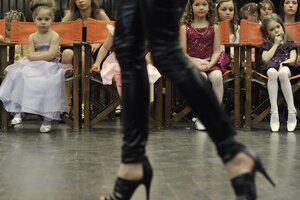Ending the hypersexualization of girls
France's move to ban beauty pageants for underage girls won't stop a trend toward Miley Cyrus-style sexual exhibitionism. Girls need to learn values that reinforce their worth beyond beauty and sex.

Girls who are contestants in the "Little Miss Hungary" beauty pageant observe a woman walking across the floor. This 2010 pageant was organized for children between 4 and 14 years.
AP Photo
France has now joined a global struggle against the sexualization of women, especially girls, in public. On Wednesday, the French upper house of Parliament voted to end beauty pageants for girls younger than 16.
The bill, which must still be approved by the lower house, was introduced to fend off a growing popularity of such pageants but also in response to public outrage over a French Vogue photo spread showing child models in tight dresses, lipstick, and high heels. Many in France were also upset that the company Jours Après Lunes came out with a line of “loungerie” – a mix of loungewear and lingerie – for girls as young as 4.
“Let us not allow our girls to think from a young age that their worth is judged only by their appearance,” said Sen. Chantal Jouanno, a champion of the pageant ban.
The proposed law is harsh. It would punish the organizers of pageants for underage girls with as many as two years in jail and a $40,000 fine. The problem with such government action is that it doesn’t address the basic problem of parents, mainly mothers, who push girls to become beauty queens or models, often forcing them to portray the hypersexualized looks of, say, a twerking Miley Cyrus.
In the United States, social campaigns are better at fighting back the trend to show young girls as alluring, even Lolita-ish. When TLC showed a 3-year-old beauty contestant dressed as a prostitute like the Julia Roberts character in the film “Pretty Woman,” the cable channel heard about it from activists and advertisers.
Groups such as the Parents Television Council (PTC) keep track of media sexualization of girls. And the fashion and movie industries do have standards for underage workers, although the rules on sexiness are constantly being tested.
In July, the PTC released a study of prime-time broadcast TV shows that found underage female characters are more likely to be presented in sexually exploitative scenes than adult women. The girl actors in such scenes were also presented more often in humorous ways.
Moral outrage over these depictions of girls should lead to public pressure on media. But more than complaints – or proposed bans like the one in France – are needed. Action is needed to counter the potential effect on girls of media that push the notion of physical beauty or sexualized behavior as the sum of one’s worth.
A 2007 report by the American Psychological Association offers “positive alternatives” to the problem of treating girls as sexual objects. It suggests that schools teach students how to critically judge popular media. Schools can also improve sex-education programs and provide better access for girls to athletics and other extracurricular programs. Parents should help children better interpret sexually explicit images in the media. Girl “empowerment” groups can provide counterexamples to sexualization.
The psychological association also recommends this: “Organized religious and other ethical instruction can offer girls important practical and psychological alternatives to the values conveyed by popular culture.”
Shaping the values of girls starts with parents, then with religious groups and schools, and then in social campaigns that watchdog the media. If beauty pageants for young girls ever disappear, it won’t come by harsh laws.

